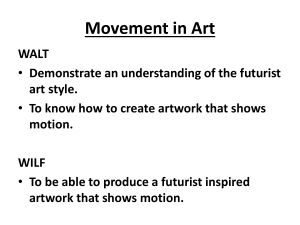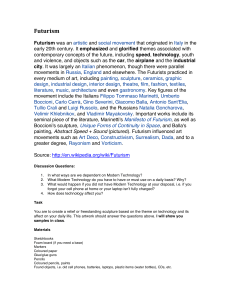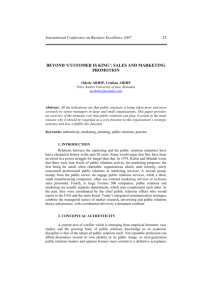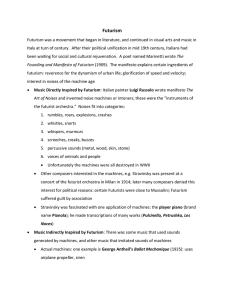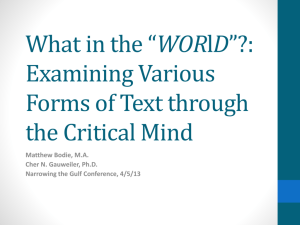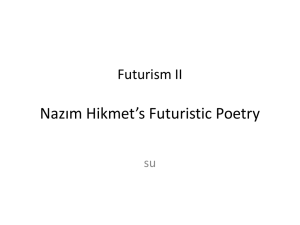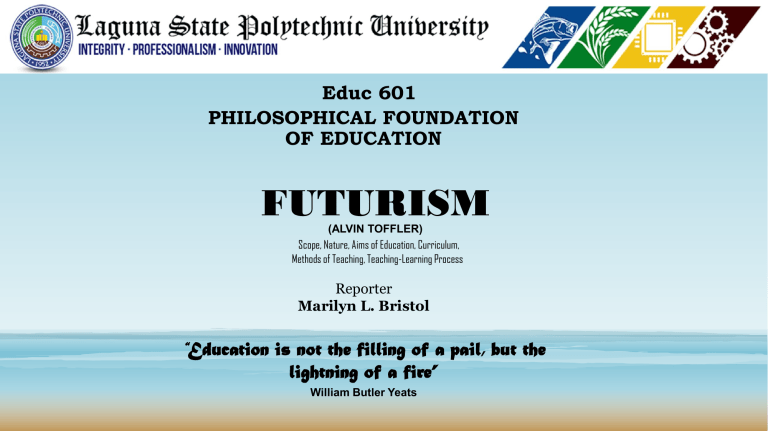
Educ 601 PHILOSOPHICAL FOUNDATION OF EDUCATION FUTURISM (ALVIN TOFFLER) Scope, Nature, Aims of Education, Curriculum, Methods of Teaching, Teaching-Learning Process Reporter Marilyn L. Bristol “Education is not the filling of a pail, but the lightning of a fire” William Butler Yeats Futurism Objectives: 1. Define Futurism. 2. Discuss the Aim of Futurism 3. Compare the Methods of teaching in the old and new school 4. Identify the features of Futuristic Education. 5. Discuss the curriculum of futurism 6. Identify what are the role of a teacher and the school to futuristic education 7. Enumerate and explain the Trilogy of Alvin Toffler (The Future Shock, The Third Wave and the Powershift) Futurism • French – FUTUR • English – Future • understanding of some people or a group of people who believe or believe in a better future, in the sense of being more modern, more concrete, and even believed that humans will be able to master the universe with the technology they have later. • proclaimed in 1909 by an Italian writer and poet, FLIPPO TOMMASO MARINETTI. • the systematic practice of trying to predict the future. Instead of possessing a connection to the great beyond, futurists are usually social scientists, technologists, and other experts who use their knowledge of the past and current trends to attempt projections of future events. • the period of time that will come after the present time (Miriam dictionary) • an Italian art movement of the early twentieth century that aimed to capture in art the dynamism and energy of the modern world Aims of Futurism Helps prepare citizens specially the younger generation to respond to change and make smart choices and develop a more pleasant future through education. Some principles that can be applied includes: ➢ Complex learning environments and authentic tasks ➢ Social Negotiations ➢ Diversity of views and representations of the discussions ➢ The process of knowledge construction ➢ Learning of students towards awareness in learning Features of Futuristic Education •Skill-based learning process •Learning with fun •Flexible learning patterns • measurement of student performance •The teachers focus on student preferences "Education is the passport to the future, for tomorrow belongs to those who prepare for it today."(Malcom X) Curriculum The contents of the curriculum are useful in the formulation of the discipline of “social science” and the process of scientific discovery (scientific inquiry) as a work method for solving social problems. ➢ ➢ ➢ ➢ ➢ ➢ ➢ Anthropology Economics & management History Human services Political science Psychology Sociology Methods of Teaching The Role of the Teacher Futurism has the same view with the notions of progressivism. 1. The teacher must make students aware of the problems faced by humans. 2. Help identify problems to solve 3. The teacher must encourage students to be able to think alternatives in solving problem 4. The teacher must help create different learning activities simultaneously. The School 1. Schools are the main agents for social, political and economic change in the community. 2. The school’s task is to develop “social engineering: with the aim of radically changing the face of society that is to come. 3. The school pioneered the community towards the desired new community. If not, each individual and group will later solve community problems individually as influence and progressivism. TRILOGY ON ALVIN TOFFLER PRESENTATION OF TRILOGY ON ALVIN TOFFLER PRESENTATION OF TRILOGY ON ALVIN TOFFLER “The illiterate of the 21st century,” Toffler wrote, “will not be those who cannot read and write, but those who cannot learn, unlearn and relearn.” Alvin Toffler & Heidi Toffler PRESENTATION OF TRILOGY ON ALVIN TOFFLER “Change is not necessary to life, it is life.” Alvin Toffler & Heidi Toffler Future Shock a. Future shock is the dizzying disorientation brought on the premature arrival of the future b. Future shock is the time phenomenon, a product of the greatly accelerated rate of change in the society, it arises from the super imposition of a new culture on an old one It is culture shock in one’s society. But its impact is far worse. NOTABLE IDEAS FUTURE SHOCK A. SUPER-INDUSTRIALIZATION ERA B. NOVELTY C. TECHNOLOGIAL TIME D. CHANGE AND KNOWLEDGE E. ACCELERATE THRUST F. TIME AND CHANGE G. DIVERSITY H. PHYSICAL AND PSYCHOLOGICAL DIMENSION I. CULTURE SHOCK I. HOW TO SURVIVE THE 21ST CENTURY 1. We are now in the 21st century 2. The beginning of modern technology. Things are change ➢ From old to new ➢ From slow to fast ➢ From difficult to an easier way ➢ Technology gives us way for the better future The Third Wave Technology Progresses Through Time First Wave- Agricultural- 8000BC-1650-1750 Second Wave- Industrial- 1750-1950 Third Wave- Informational- 1950-2004 Four1th Wave- Nano/Biotechnology 2004-??? First Wave: Agricultural-8000BC-1650-1750 Characteristics ❖ Communication—Oral was common ❖ Family Structure- Extended family ❖ Economy—Hunting/fishing important for food ❖ Production- Solar energy, natural resources very ❖ important ❖ Education—Home schooling, individual ❖ Politics –Individual classified by politics Second: Industry 1750-1950 Characteristics ❖ Family Structure – Nuclear Families ❖ Education – Rote and repetition teaching practices ❖ Economy – Trade with foreign countries ❖ Production – Factories, assembly lines ❖ Communication – newspapers, tvs ❖ Politics – wars, strikes, crisis, and political uprisings Third Wave—Informational—1950-2004 ❖ Economy-Global industry, supply of oil and gas ❖ Family—2 parents work, more single-parent homes and grandparents raising their grandchildren ❖ Education- secondary schools offer distance and ❖ online courses, Internet, digital networks ❖ Politics- Variety of government s such as ❖ democracies, socialism, capitalism ❖ Communication—Twittering, texting from cell ❖ phones, computer phones, computers and laptops ❖ Production-Medical discoveries, cars with special ❖ features, science inventions, Fourth Wave—2005--??? According to Dr. Thornburg and Dr. Dede there will be a fourth wave. They have predicted that this age will include biotechnology related products that will be more durable and creative. Powershift : knowledge, wealth, and violence at the edge of the 21st century In Powershift, Toffler argues that while headlines focus on shifts of power at the global level, equally significant shifts are taking place in the everyday world we all inhabit—the world of supermarkets and hospitals, banks and business offices, television and telephones, politics and personal life. The very nature of power is changing under our eyes. Conclusion Education can be seen on two sides, namely as practice and education as a theory. Associated with efforts to study education as a theory can be done through a philosophical approach, one of which is the flow of futurism. In its application to the world of education and learning, that the flow of futurism requires learning is a conscious effort of students to think and act today to face the future and the ability needed to be able to face the turmoil of change is so fast. Learning is not a dogmatic process. Learning must have a character centered on students. Futurism aims to help prepare citizens in this case the younger generation to respond to change and make smart choices considering that humanity moves into the future that has more than one configuration. So that futurism philosophy aims to develop a more pleasant future through education. . References: (https://www.soencouragement.org/Essays%20on%20Education%20and%20Educational%20Philosophy.pdf) (https://blog.edmentum.com/how-apply-futurism-education) https://ezyschooling.com/parenting/expert/futuristic-education https://www.slideshare.net/OmoyajowoOlaoluwa/future-shock-new-new-new-slide https://vdocuments.mx/strand-one-tofflers-three-waves.html https://repositories.lib.utexas.edu/bitstream/handle/2152/25709/PowershiftbyAlvinToffler.pdf?seq uence=5 https://www.merriam-webster.com/dictionary/future https://www.tate.org.uk/art/art-terms/f/futurism
